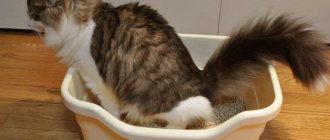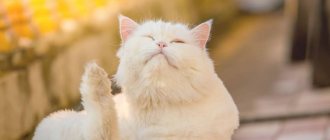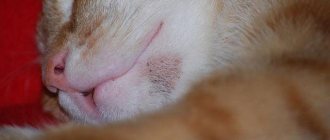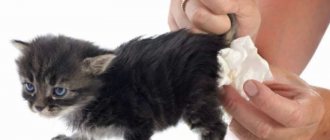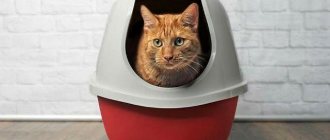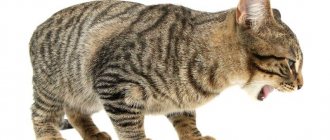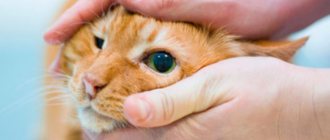Cat owners often have to deal with various health problems with their pets. The lion's share of diseases occurs in the gastrointestinal tract; representatives of the cat family especially often suffer from digestive disorders such as diarrhea or diarrhea. In most cases, bowel dysfunction does not pose a threat to the pet’s life and does not require drug therapy. However, in some cases, frequent loose stools may signal the development of a serious illness. Especially if there is blood in the stool, the animal’s condition deteriorates sharply, an upset stomach is accompanied by vomiting, the temperature rises, etc. In this case, it is important to know what to do and how to properly treat diarrhea in cats.
What is diarrhea in cats
Diarrhea (diarrhea) is not an independent disease; the condition is a signal of the presence of certain health problems in the cat. We are talking about dysfunction of the digestive tract, which is accompanied by excessive loss of fluid, pain in the abdomen, nausea, vomiting, weakness and loss of appetite. In cats, frequent loose stools are caused by increased intestinal motility, provoked by irritation of the intestinal mucosa by pathogenic bacteria or toxins.
Along with frequent defecation, the animal behaves restlessly, experiences discomfort, and often cannot find a place for itself. Despite the fact that in the vast majority of cases, a disorder of the digestive system does not pose a threat to the cat’s life, it is important to understand that prolonged diarrhea can lead to dehydration and can cause the death of the pet. It is extremely important to correctly recognize the symptoms of the disorder and promptly help the animal on your own at home or in a hospital.
Main predisposing factors
The causes of diarrhea in kittens are extremely varied. This includes both simple stress (including weaning and moving to a new home) and very serious pathologies, including feline panleukopenia. Very often, diarrhea is a consequence of using low-quality feed.
Let's consider several situations in which a kitten's feces can turn greenish:
- Overfeeding.
- Cow's milk. The digestive tract of many kittens cannot digest it at all. In the lumen of the intestines, many casein clots form, which rot.
- Spoiled food.
- Changing your diet.
- Weaning from mother.
- Stress.
- Helminthiases.
- Protozoal infections. “Green” diarrhea is especially characteristic of giardiasis and cryptosporidiosis.
- Bacterial or viral infections (for example, infectious enteritis).
- Diabetes.
- Oncological diseases.
Symptoms of diarrhea
The symptoms of diarrhea are pronounced, the condition involves a frequent urge to empty the intestines, while the volume of a single bowel movement is less than usual, and the consistency is liquid. In addition, among the most common symptoms it is worth noting:
- acts of defecation – more than 3 times per day;
- watery, unformed stools;
- fecal incontinence, urgent urge to defecate;
- the color of the feces is light with shades of yellow, green, red if there is diarrhea with blood, and even black if the animal has damage to internal organs.
In addition, vomiting, painful spasms, lethargy, apathy and loss of appetite and other symptoms are often added to the existing picture. It is extremely important to recognize the symptoms in time and identify the root causes of the painful condition in order to understand what to do and what kind of help the cat needs.
Prevention
The deterioration of the cat's condition and the presence of attacks of diarrhea can be prevented. This is not difficult to do: you just need to improve the cat’s nutrition and strengthen its immunity.
Preventive measures:
choose high-quality food from well-known, trusted brands for feeding your cat;- store household chemicals out of reach of animals;
- Deworm your cat every six months;
- Monitor your pet’s appetite and stool, and respond in a timely manner to any changes in your pet’s condition.
It is important to hide sweets from cats: such food attracts animals, but is toxic to them.
Causes
The most common cause of problems with the digestive tract is a change in the cat's usual diet. If frequent bowel movements occurred during the introduction of changes in diet, we can say with confidence that the cause of the disease lies precisely in this. In this case, indigestion can be cured without special therapy. All you need to do is return to your usual food. However, the causes of digestive disorders in cats are not limited only to errors in nutrition; a number of household factors can provoke a painful condition:
- unbalanced diet - the presence in the pet’s diet of raw fish, dairy products, fatty foods, which can cause digestive problems;
- too large portions or frequent feeding;
- transition from natural food to special food or vice versa;
- low-quality water, a change in its usual composition can affect the functioning of the gastrointestinal tract;
- food poisoning: a pet may suffer from consuming spoiled food that has expired;
- individual intolerance to any product, allergies;
- dysfunction of the digestive tract can be caused by medications; manufacturers of veterinary drugs often list diarrhea in the list of side effects;
- postoperative period;
- postpartum rehabilitation and the period of gestation are also often accompanied by gastrointestinal disorders.
Frequent urges to defecate may be caused by an unstable emotional state of the cat. An experienced stressful situation, unfavorable home conditions, excitement, fear, the appearance of other pets in the house, long-term separation from the owner, the arrival of guests, or moving can cause diarrhea. These factors should not be a cause for concern; usually, special treatment is not required, the pet recovers on its own immediately after the disappearance of the traumatic factor.
At the same time, the cause of diarrhea with blood in a pet (or without bloody discharge) may lie in the presence of life-threatening diseases:
- salmonellosis, E. coli infection and other bacterial infections;
- diarrhea and vomiting in a cat with white foam can be caused by viral diseases, including the so-called feline leukemia, rotavirus, panleukopenia, etc.;
- the causes of green diarrhea in a pet can be a consequence of various liver diseases, including pancreatitis;
- diarrhea in cats is caused by pathologies of the digestive system of various etiologies, including partial or complete intestinal obstruction;
- intoxication of the body that developed as a result of complex drug therapy or caused by severe poisoning;
- metabolic disorders, including diabetes;
- parasitic lesions of the body - roundworms, helminthic infestations, worms;
- oncology;
- pathologies of the urinary system;
- fungal infections (mycoses).
Separately, it is worth noting the causes of vomiting with white foam with frequent acts of defecation; their nature is most often physiological, thus the pet independently gets rid of undigested food and toxins. In the absence of accompanying symptoms that aggravate the animal’s health, special treatment is not necessary.
Drug treatment
How can you quickly stop diarrhea in your pet? In these cases, you can use special medications to treat diarrhea in cats, but you should not use them yourself. You should definitely consult your veterinarian first.
So how to treat your pet, what anti-diarrhea tablets can you use? Let's look at the most effective and popular medications that help quickly cure symptoms of diarrhea.
Metronidazole
Many veterinarians recommend using this drug as little as possible to stop diarrhea at home. Metronidazole puts increased stress on your pet's kidneys and liver. But in some cases the medicine shows increased effectiveness.
It is recommended to use tablets when diarrhea is caused by helminth infection. The drug is also highly effective against bacterial infections.
Affects various simple organisms, among which are:
- Giardia;
- Trichomonas;
- parasitic ciliates (from the genus Balantidium).
But before using it for diarrhea in a cat, you should carefully study the possible side effects:
- Manifestations of allergies may occur - shortness of breath, urticaria;
- Increased salivation;
- Vomiting;
- Decreased appetite;
- Increased diarrhea;
- A state of apathy, sometimes the animal falls into a coma;
- Sometimes blood may appear in the urine.
Activated carbon
If you are thinking about what to give your cat for diarrhea, you can use activated charcoal. People also take this remedy to treat diarrhea. The principle of action of the medicine is based on adsorption, namely, the active elements absorb toxins and harmful components.
This is a harmless medicine that can even be used to treat diarrhea in a pregnant cat. The dosage is usually calculated according to the weight of the pet. But if you give more than the prescribed dose, then nothing bad will happen.
Features of application:
- usually for an animal weighing 2.5 kilograms you can use 3-4 tablets;
- The tablets need to be ground to a powder;
- the powder can be added to cat food or diluted in water;
- then you need to draw the liquid into a syringe and pour it into the pet’s mouth;
- pouring should be done every 5-6 hours until the symptoms of diarrhea disappear.
Smecta
For diarrhea and symptoms of indigestion, you can give your cat Smecta. This medicine is often used for people with diarrhea and dehydration. It has a neutral taste, so there are usually no problems with its use.
In order to cure diarrhea and your pet, you should follow important recommendations when using Smecta:
- For a cat or cat weighing 2.5 kilograms, 1 sachet of the drug should be used;
- the powder must be diluted in a small amount of warm boiled water;
- after the medicine has dissolved, it should be drawn up with a syringe;
- a small amount of liquid is poured directly into the animal's throat.
The drug has no contraindications. For this reason, Smecta can be given to a kitten, and it can also be used to treat diarrhea in a nursing cat.
Enterosgel
Enterosgel appeared in pharmacies quite a long time ago and is extremely popular. The thing is that the medicine has an adsorbent effect, namely, it absorbs harmful components from the walls of the stomach and intestines.
With its help, you can treat not only diarrhea, but also use it as a prophylactic for allergies and diseases associated with disruption of the digestive system.
The drug is safe for cats and cats, it does not cause side symptoms and has no contraindications. An adult cat needs to be given 1 teaspoon of medicine per day, but kittens need ½ teaspoon once a day.
Loperamide
Loperamide is considered a popular antidiarrheal drug used by many travelers. It can also be used to treat diarrhea in animals.
When using Loperamide for cats, you should follow important recommendations:
- for animals weighing 2.5 kilograms, you need to use ½ part of the tablet;
- before giving, the tablet must be broken and ground to a powder;
- The tablet can be given with food or diluted in water and poured into the mouth;
- It is recommended to give kittens in small doses - ¼ or 1/8 of a pill.
Furazolidone
Furazolidone has been used in the treatment of diarrhea for quite some time. The medicine belongs to the group of nitrofurans and has an effective effect on gram-positive and gram-negative bacteria.
Note! The medicine is highly effective against diarrhea pathogens in cats. However, you should be careful when using it, the fact is that the active components place a strong load on the animal’s liver. For this reason, the dose of Furazolidone should be minimal.
The daily dose of the drug should be no more than ¼ tablet, and it must be divided into three doses. The tablet is ground to a powder, diluted in water and poured down the cat’s throat.
Types of diarrhea in cats
Depending on the causes of the eating disorder, stool takes on different colors, textures and smells. Based on the analysis of these parameters, it is possible to draw a conclusion about the presence of a particular disease and determine a course of treatment at home.
Classification of diarrhea according to consistency and the presence of foreign impurities in the stool:
- liquid diarrhea, the presence of vomiting most likely indicates food poisoning;
- the presence of mucus in stool indicates damage to the large intestine;
- blood in the stool indicates the infectious nature of diarrhea, the presence of parasites, or indicates damage to internal organs.
Depending on the color of the stool, the following types of diarrhea are distinguished:
- yellow stool – incomplete digestion of food eaten;
- black color - indicates the presence of internal bleeding (you should seek emergency veterinary help or call a veterinarian at home), may also be a consequence of taking medications containing iron or indicate an excessive meat diet;
- green color - with a high degree of probability indicates the consumption of spoiled foods that provoke rotting processes in the intestines; you can treat green diarrhea yourself;
- white color - indicates the presence of problems in the biliary tract;
- orange color - the pet is experiencing severe intoxication and needs emergency help.
Why?
We will talk today only about the age period, starting from 2 months (and up to 1 year), because it is at this moment that kittens are most often “given into good hands,” that is, they are taken, firstly, from their usual home environment and, secondly, they change the diet, thereby violating the 2 main “strongholds of health” of the baby.
So, digestive disorders in kittens at this age occur much more often than in adult cats (and they are more dangerous!), because the gastrointestinal tract is still “learning” to work, like the whole body, it is rapidly growing and forming. The immune system is also gaining strength.
And we need to learn: to be able to recognize the two main “provocateurs” of this problem.
The first of them: conditions of detention:
- as a result of inattentive or illiterate care for pets;
- when weaning from the mother too early, and even if not early, feeding instead of milk with food that the baby’s weak intestines cannot yet absorb.
Second: diseases and pathologies.
Let's consider both cases in detail.
How can I help you?
In severe cases, dehydration occurs quickly. It is indicated by:
- the fold of skin on the withers, if you pull it back, straightens out in more than 2 seconds;
- no shine in the whites of the eyes;
- the nose and mucous membranes of the mouth are dry.
The doctor will prescribe: injections or drips to relieve intoxication and administer nutrients; diet, procedures and medications, and sometimes operations.
Home help will also be required from the owner using the methods that he knows (some of them are listed above*), but strictly in agreement with the doctor!
For example, Phthalazol tablets (for humans) are suitable for diarrhea:
- Crush ¼ tablets into dust, shake until suspended in 2-5 ml of warm boiled water (measure with a syringe);
- immobilize the cat by wrapping it in a towel, inject a few drops into the side of the mouth with a syringe and stroke and soothe it while it swallows this tasty medicine; and so on until it ends.
Only 2 doses of Phthalazol (morning and evening) will help.
For infrequent vomiting, use 1 tbsp 3 times a day. l. any of these remedies: a decoction of rice, chamomile, flax seeds or oak bark; St. John's wort infusion.
